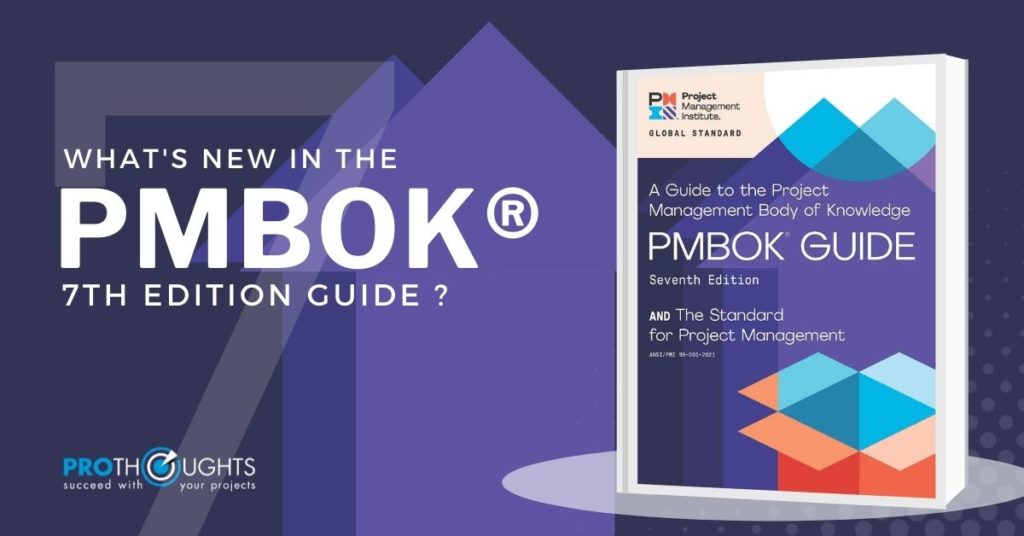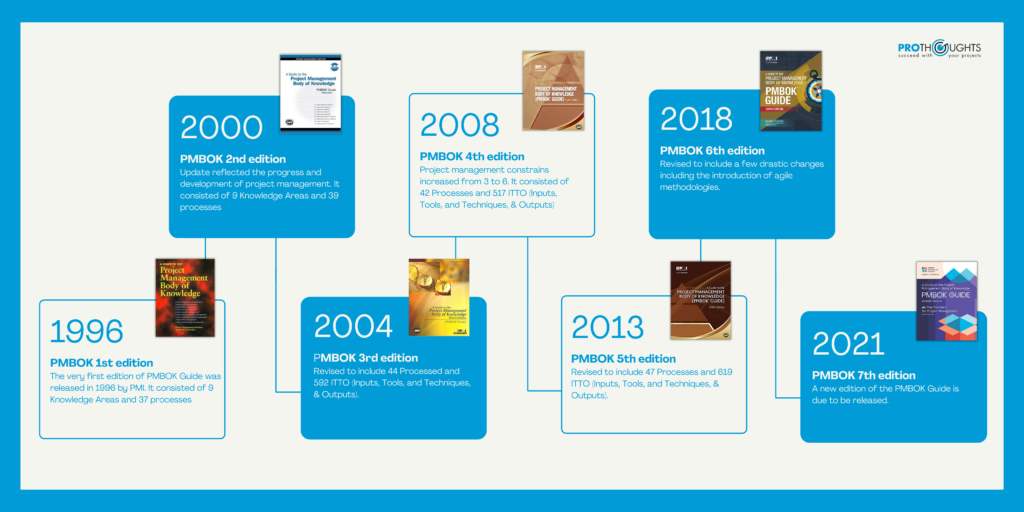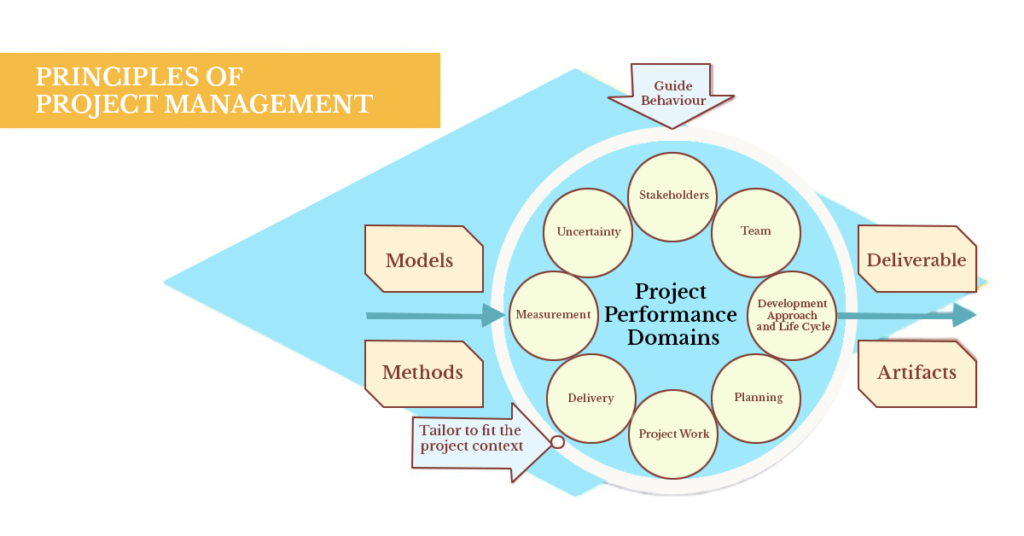The newly launched PMBoK 7th Edition looks remarkably different from the current PMBOK 6th edition. Anything new and exciting is always welcome and in this rapidly changing world, being relevant is something that we all like to be.
History of PMBOK
Please find below the history of PMBOK changes starting from all the way back in the year 1996 when PMBOK Version 1 was launched. Since then, Project management Institute has revised the PMBOK version every 3-5 years. Reason for this periodic revision every 3 – 5 years is mentioned below.
The evolution of technology has changed the way work gets done for many professions, including project management. Based on feedback from project managers across industries and around the world, it was felt that there was room to improve the content and structure to reflect current ways of working. Practitioners are now tasked with identifying the right delivery approach (predictive, adaptive or hybrid) to get the job done and deliver value. PMBOK® Guide updates are needed regularly in order to stay relevant and meet the needs of all the stakeholders involved.
PMI had released the exposure draft of PMBOK Edition 7 in 2020 accessible to all active PMI members. Now that is no more accessible after the launch of PMBOK 7 on August 1, 2021. That was done for multiple purposes:
- Create a buzz or awareness on the upcoming launch
- Give candid overview of the new PMBoK and the direction in which project management is moving.
- Get feedback from practitioners and experts to incorporate before the final launch
PMBOK 7 is now available before the launch as well to be downloaded by all PMI active paid members from PMI Website. It is a concise 370 pages book which is not replacing the detailed PMBOK 6th Edition (794 pages). Rather it gives an additional approach and adds more value to project management. Hence PMBOK 6th Edition continues to be the basis of all exams offered by PMI. PMBOK 6 can be downloaded as well from the same location on PMI Website as mentioned above.
Let’s take a peek inside the new PMBOK 7th edition updates and also some behind the scenes updates.
PMBOK 7th Edition is relevant to all the project all the times as compared to earlier versions that were relevant to most of the projects most of the times.
- PMBOK 7 is segregated in 2 sections:
- The Standard for Project Management
- A Guide to the Project Management Body of Knowledge
- Focus is shifted from:
- Creating Deliverables to Creating Value (PMBOK Standards)
- 49 Processes and 5 Process Groups to 12 Principles (PMBOK Standards)
- 10 Knowledge Areas to 8 Performance Domains (PMBOK Guide)
- 600+ ITTOs (Inputs-Tool-Techniques-Outputs) to Models, Methods and Artifacts (PMBOK Guide)
- Simple mention of tailoring to defining a comprehensive tailoring framework (PMBOK Guide)
- Digital content platform – PMIstandards+: Launched and offered to PMI Members to understand and practically apply, all that is talked about in PMBOK 7
What ProThoughts expert Arvind Nahata has got to say about PMP Exam based on PMBOK 7th Guide & Standards?
PMBOK Standards: Creating Value through Project Management
There is more emphasis on creating VALUE. Not that, it was not there earlier and projects are meant to deliver business value. However, in the new edition, there has been a focus on Value and linking it with the Strategic objectives of the organization. Projects are always meant to do that.
In the 7th edition, they are introducing “Value-Based Delivery” in the current changing dynamic world of project management.
This will be a collection of strategic business objectives aimed at building, sustaining and/or advancing an organization. The Value-based Delivery system emphasizes a broad application of concepts, practices, and techniques for producing value in an increasingly complex business context.
In the new edition, the synergies between Portfolios, Programs, Projects, and Operations has been more pronounced and spelled out more effectively.
The above diagram clearly articulates the relationship between strategy and the various components of Project Management. While Projects rely on business outcome and Programs should rely on creating benefits from the outcome, Operations focus on Benefits realization.
To further illustrate the point, the Value Delivery System spans out as following:
It operates within the constraints and context of both the internal environment and the external environment.
The change as we see in the 7th Edition it is the Value Delivery System majorly in the 1st two chapters. The rest of the things are as they were in the earlier sections which are Roles in Project Management (although more detailed), Enterprise Environment Factors and Organization Process Assets.
PMBOK Standards: 12 Principles of Project Delivery:
Another major change what 7th Edition brings out is the 12 Principles of Delivery – very akin to Agile Principles. The number surprisingly is also the same – 12. In our opinion, these principles are given when one practices project management; however, PMI proposes to make it a standard commentary across the delivery of a project. There is a good amount of literature surrounding these 12 principles. Purpose and intent of introducing these 12 principles seems to be building a mindset and approach, very similar to Agile and perhaps taking this approach head-on with Agile approach and practices.
The 12 principles are as follows:
- Be a Diligent, Respectful, and Caring Steward
- Create a Collaborative Project Team Environment
- Effectively engage with stakeholders
- Focus on value.
- Recognize, Evaluate and Respond to System Interactions.
- Demonstrate Leadership Behaviors
- Tailor Based on Context.
- Build Quality into Processes and Deliverables.
- Navigate Complexity
- Optimize Risk Responses
- Embrace Adaptability and Resiliency.
- Enable Change to Achieve the Envisioned Future State.
PMBOK Guide: The 8 New Project Performance Domains:
The below mentioned 8 Project Performance Domains can be considered as an alternative to the 5 Process Groups, though it does not come out clearly neither is such correlation defined in the PMBOK 7.
- Stakeholder
- Team
- Development Approach and Life Cycle
- Planning
- Project Work
- Delivery
- Measurement
- Uncertainty
PMBOK Guide: Models, Methods and Artifacts:
Regarding Models, Methods and Artifacts under PMBOK 7 – Guide section, categorization is done as follows:
Commonly Used Models:
- Situational Leadership Models
- Communication Models
- Motivation Models
- Change Models
- Complexity Models
- Project Team Development Models
- Other Models
Commonly Used Methods:
- Data Gathering and Analysis
- Estimating
- Meetings and Events
- Other Methods
Commonly Used Artifacts:
- Strategy Artifacts
- Logs and Registers
- Plans
- Hierarchy Charts
- Baselines
- Visual Data and Information
- Reports
- Agreement and Contracts
- Other Artifacts
These seem to be the counterpart of earlier ITTOs (Inputs-Tools-Techniques-Outputs).
The phrase that really fits in well here is: Same old wine in more attractive and bigger bottle.
In fact, Process Groups is one of the models in the Models, Methods, and Artifacts section of the guide. The concepts from the Knowledge Areas can be seen in multiple project performance domains.
So far, the 7th edition is spanning out good and is a welcome change as we intend to stay relevant in the world of project management. We would be closely following all the upcoming changes and announcements.
Check out this space for more announcements
What should a PMP Certification Aspirant do next?
Project Management Institute launched PMBOK 7th Edition earlier this year in August 2021. PMBOK 6th Edition was launched a few years back in March 2018. They normally revise the PMBOK guide every 5-6 years approximately but this time they revised it much earlier. The reason that seems obvious is the Agile approach to Project Management and the much faster adoption cycle in the recent past.
But unlike all the previous launches, this time their certification courses including PMP and CAPM are still based on PMBOK 6th Edition. When enquired, the response received was that PMBOK Guide is just a benchmark but certification exams are based on Exam Content Outline (ECO) which was last modified effective Jan 2, 2021. One of the major changes was the weightage of Agile methodology increased to 50% anyways. They have also mandated new study materials (primarily focused on Agile) in the form of the PMI Logical Operations Choice Platform. That takes care of the new syllabus addition to PMBOK 6th edition for the PMP certification exam.
And till further notice, it is just rumored that the PMP Certification exam is based on PMBOK 7.
We highly recommend to all PMP aspirants to get PMP certification done as soon as possible due to the following 2 reasons:
- Agile indirectly is already included in a big way in PMP in the form of the Student manual being provided by PMI.
- There is a big uncertainty as to when PMP Exam will be based on PMBOK 7
So, now that you have understood the changes on PMBoK 7th Edition, you can start creating a roadmap for your PMP Certification Journey and stay updated if you are already PMP Certified.
You can check your eligibility if you are planning for PMP Certification training and follow ProThoughts for the latest updates on the upcoming batch dates and important events.









